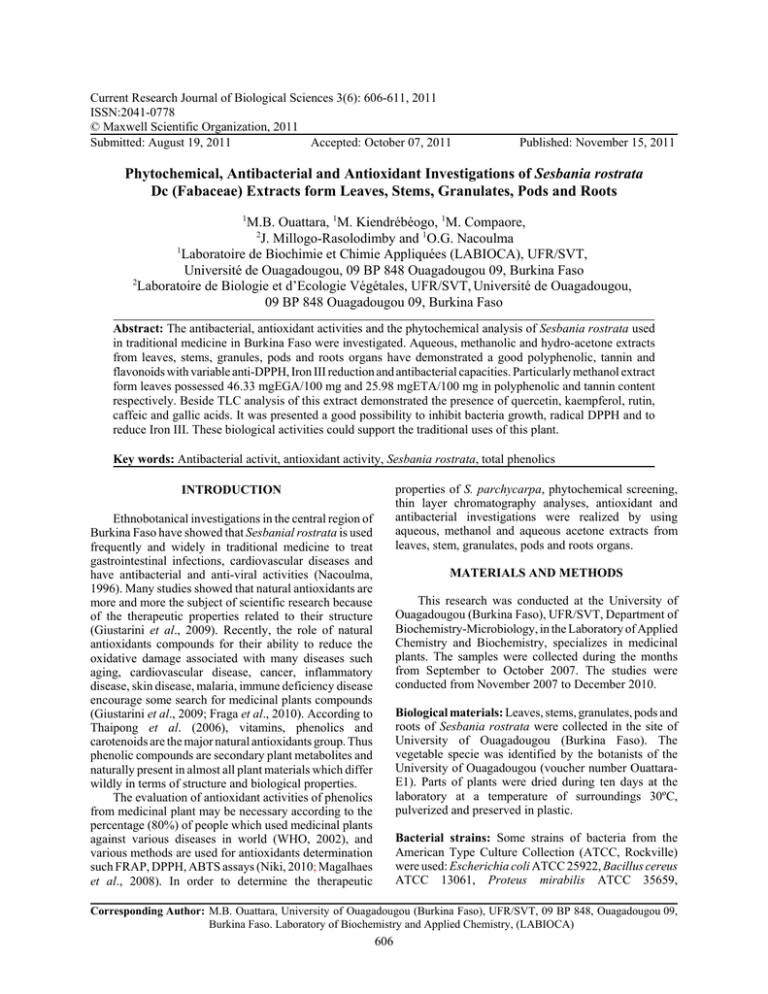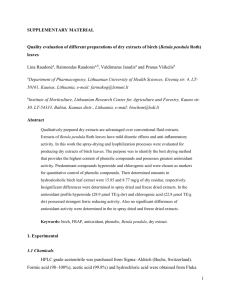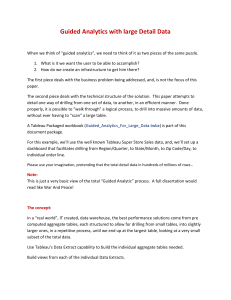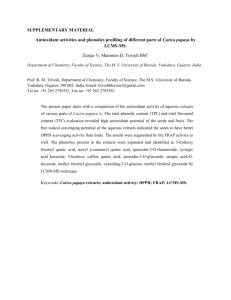Current Research Journal of Biological Sciences 3(6): 606-611, 2011 ISSN:2041-0778
advertisement

Current Research Journal of Biological Sciences 3(6): 606-611, 2011 ISSN:2041-0778 © Maxwell Scientific Organization, 2011 Submitted: August 19, 2011 Accepted: October 07, 2011 Published: November 15, 2011 Phytochemical, Antibacterial and Antioxidant Investigations of Sesbania rostrata Dc (Fabaceae) Extracts form Leaves, Stems, Granulates, Pods and Roots 1 M.B. Ouattara, 1M. Kiendrébéogo, 1M. Compaore, 2 J. Millogo-Rasolodimby and 1O.G. Nacoulma 1 Laboratoire de Biochimie et Chimie Appliquées (LABIOCA), UFR/SVT, Université de Ouagadougou, 09 BP 848 Ouagadougou 09, Burkina Faso 2 Laboratoire de Biologie et d’Ecologie Végétales, UFR/SVT, Université de Ouagadougou, 09 BP 848 Ouagadougou 09, Burkina Faso Abstract: The antibacterial, antioxidant activities and the phytochemical analysis of Sesbania rostrata used in traditional medicine in Burkina Faso were investigated. Aqueous, methanolic and hydro-acetone extracts from leaves, stems, granules, pods and roots organs have demonstrated a good polyphenolic, tannin and flavonoids with variable anti-DPPH, Iron III reduction and antibacterial capacities. Particularly methanol extract form leaves possessed 46.33 mgEGA/100 mg and 25.98 mgETA/100 mg in polyphenolic and tannin content respectively. Beside TLC analysis of this extract demonstrated the presence of quercetin, kaempferol, rutin, caffeic and gallic acids. It was presented a good possibility to inhibit bacteria growth, radical DPPH and to reduce Iron III. These biological activities could support the traditional uses of this plant. Key words: Antibacterial activit, antioxidant activity, Sesbania rostrata, total phenolics properties of S. parchycarpa, phytochemical screening, thin layer chromatography analyses, antioxidant and antibacterial investigations were realized by using aqueous, methanol and aqueous acetone extracts from leaves, stem, granulates, pods and roots organs. INTRODUCTION Ethnobotanical investigations in the central region of Burkina Faso have showed that Sesbanial rostrata is used frequently and widely in traditional medicine to treat gastrointestinal infections, cardiovascular diseases and have antibacterial and anti-viral activities (Nacoulma, 1996). Many studies showed that natural antioxidants are more and more the subject of scientific research because of the therapeutic properties related to their structure (Giustarini et al., 2009). Recently, the role of natural antioxidants compounds for their ability to reduce the oxidative damage associated with many diseases such aging, cardiovascular disease, cancer, inflammatory disease, skin disease, malaria, immune deficiency disease encourage some search for medicinal plants compounds (Giustarini et al., 2009; Fraga et al., 2010). According to Thaipong et al. (2006), vitamins, phenolics and carotenoids are the major natural antioxidants group. Thus phenolic compounds are secondary plant metabolites and naturally present in almost all plant materials which differ wildly in terms of structure and biological properties. The evaluation of antioxidant activities of phenolics from medicinal plant may be necessary according to the percentage (80%) of people which used medicinal plants against various diseases in world (WHO, 2002), and various methods are used for antioxidants determination such FRAP, DPPH, ABTS assays (Niki, 2010; Magalhaes et al., 2008). In order to determine the therapeutic MATERIALS AND METHODS This research was conducted at the University of Ouagadougou (Burkina Faso), UFR/SVT, Department of Biochemistry-Microbiology, in the Laboratory of Applied Chemistry and Biochemistry, specializes in medicinal plants. The samples were collected during the months from September to October 2007. The studies were conducted from November 2007 to December 2010. Biological materials: Leaves, stems, granulates, pods and roots of Sesbania rostrata were collected in the site of University of Ouagadougou (Burkina Faso). The vegetable specie was identified by the botanists of the University of Ouagadougou (voucher number OuattaraE1). Parts of plants were dried during ten days at the laboratory at a temperature of surroundings 30ºC, pulverized and preserved in plastic. Bacterial strains: Some strains of bacteria from the American Type Culture Collection (ATCC, Rockville) were used: Escherichia coli ATCC 25922, Bacillus cereus ATCC 13061, Proteus mirabilis ATCC 35659, Corresponding Author: M.B. Ouattara, University of Ouagadougou (Burkina Faso), UFR/SVT, 09 BP 848, Ouagadougou 09, Burkina Faso. Laboratory of Biochemistry and Applied Chemistry, (LABIOCA) 606 Curr. Res. J. Biol. Sci., 3(6): 606-611, 2011 extract, 500 :L of reagent of Folin-Ciocalteu (0.2 N) were mixed and incubated during 5 mn, following by adding 400 :L of aqueous sodium carbonate solution (75 g/L). After dark incubation the absorbencies were read at 760 nm. The gallic acid is used as standard for the establishment of the curve (y = 0.0095x, with R2 = 0.99). Salmonella typhimirium ATCC 13311 and Staphylococcus aureus ATCC 6538. Among the strains bacteria, Escherichia coli, Proteus mirabilis and Salmonella typhimirium are Gram-negative bacteria; Bacillus cereus and Staphylococcus aureus are Grampositive bacteria. Other isolated strains (wild) of S. aureus and of Vibrio cholerae were used. Total flavonoid determination: Flavonoid amount was estimated by using procedure descried previously (Lamien-Meda et al., 2008). 500 :L of extract and 500 :L of AlCl3 (2%) were incubated for 10 min and the absorbance was read at 415 nm. Quercetin was to produce standard curve (y = 0.0249x, with R2 = 0.99). Chemical material: All reagents were of analytical grade. Folin-Ciocalteu reagent, Dragendorff reagent, Na2CO3, NaOH, gallic acid, quercetin, AlCl3 chlorhydric acid, magnesium Chloride, (Steinheim, Germany); ammonium ferric citrate (CAF), potassium persulfate, DPPH (2, 2’-diphenyl-1-picrylhydrazyl, Fluka), and trichloroacetic acid were supplied by Fluka chemie (Buchs, Switzerland); sulfuric acid, Anhydrid acetic, Ferric trichloride, Chloroform, Ethanol, Methanol, potassium hexacyanoferrate (III) [K3Fe(CN)6] was sourced from Probalo (Paris, France); ascorbic acid, tannic acid were supplied by Labosi (Paris, France). Tanin content determination: The total tannin content was evaluated by using the reference method of European Community (2000). Briefly, 200 :L of extract was mixed with 1 mL of distilled water, 200 :L of ferric ammonium citrate (3.5 g/L) prepared freshly and 200 :l of ammoniac (20%). The solution absorption is measured at 525 nm after 10 min of incubation against a blank. Tannic acid (0-150 mg/L) was used as reference compound to produce the standard curve, (y = 0.0011× +0.22, R2 = 0.99) and the results were expressed as mg of tannic acid equivalent (TE)/g of extract. Preparation of extracts: Aqueous extraction: 25 g of vegetable powdered was extracted with 250 mL of distilled water during 30 min at 100ºC. After filtering the extract was freeze-dried (Telstar cryodos 50, England). Biological investigations: Antioxidant activity: DPPH assay: Determination of the antioxidant activity of the extracts was realized by DPPH method (Lamien-Meda et al., 2008) with slight modifications. Briefly: 250 :L of variation concentration extract in methanol and 500 :L of the solution of DPPH (20 mg/L) were incubated during 10 min. The absorbance was read at 517 nm and the percentage of inhibition calculated in order to determine the concentration that was able to inhibit 50% graphically. Methanolic extraction: 25 g of powdered was extracted with 300 mL of methanol by using Soxhlet apparatus. The extracts were Wltered and evaporated to dryness in a rotary evaporator. Hydro-acetone extraction: Weigh 25 g of powder vegetable and pour 250 mL of aqueous acetone (80%). After filtration, acetone was removed under reduced pressure using a rotary evaporator and the remaining aqueous solution was freeze-dried. Thin Layer Chromatography (TLC): Thin layer chromatography for phenolic acid and flavonoid was realized by Wagner and Bladts (1996) and Medié-Sarié et al. (2004) methods by using plates (selica gel 60F254, KIESEL GEL, 10 cm×10 cm) which spotted by standards and samples. The system of migration used is ethyl acetate/formic acid/acetic acid glacial/ water (7/1.1/1.1/2). FRAP assay: The iron (III) reduction ability of extract was performed according to Lamien-Meda et al. (2008). Briefly, 0.5 mL of each extract (1 mg/mL) was mixed with 1.25 mL of phosphate buffer and 1.25 mL of aqueous potassium hexacyanoferrate solution. After 30 min incubation at 50ºC, 1.25 mL of trichloroacetic acid (10%) was added and the mixture was centrifuged at 2000 × rpm for 10 min. Then, the upper layer solution (0.625 mL) was mixed with distilled water (0.625 mL) and a freshly prepared FeCl3 solution (0.125 mL, 0.1%). Absorbencies were read at 700 nm and ascorbic acid was used to produce the calibration curve (Y = 0.008x-0.0081; R2 = 0.99). The iron (III) reducing activity determination was determined in triplicate and expressed in mmol Ascorbic Acid Equivalent per g of extract. Determination of total phenolics: Spectrophotometrical method described by Lamien-Meda et al. (2008) was used to quantify polyphenol in extract. Briefly, 100 :L of Antibacterial activity: inhibition zone determination: The Diameter of inoculum of bacterial strains was adjusted to Mc Farland Phytochemical investigations: Qualitative phytochemical screening: Firstly, the procedures described by Ciulei (1982) were used to characterize the main phytochemical groups namely polyphenol, tannin, flavonoids, alkaloids, triterpenes/steroids, and coumarins in extracts. 607 Curr. Res. J. Biol. Sci., 3(6): 606-611, 2011 Table 1: Tests of characterization of aqueous and methanolic extracts of Sesbania rostrata (+): positif test (-): negative test Triterpens and Alkaloïds Coumarins Flavonoids Saponosides free steroids Aqueous extract of S. rostrata Leaves + + + + + Stems + + + + + Granulates + + + + Pods + + + + Roots + + + + Méthanolic extract S of S. rostrata Leaves + + + + + Stems + + + + Granulates + + + + Pods + + + + Roots + + + + Tanins and polyphenols + + + + + + + + + + solution turbidity (106 colonies forming units (cfu) per mL (Ezoubeiri et al., 2005). In each Petri plate containing solid medium, 3 mL of inoculum, was used. After eliminating fxcess from inocula, the disk containing the extracts or reference antibiotics (penicillin, ampicillin) was put following incubation during 24 h. The diameter of zone inhibition superior at 9 mm was considered. While, saponosides were not found in aqueous extract. Quercetin, kaempferol, rutin, caffeic and gallic acids were found in methanol extract mainly from leave and stem by TLC analysis. These different groups of compound could be participating to the antibacterial and antioxidant activities as showed previous studies (Gibbons, 2008; Sultana et al., 2009; Cushnie and Lamb, 2005). Minimal inhibition concentration (MIC): Minimum inhibition concentration (MIC) was determined by the microdilution method in culture broth as recommended by Eloff (1999) and the National Committee for Clinical Laboratory Standard (NCCLS, 2001). The 96-well microplate (NUNC, Danemark) containing 100 :L of Mueller Hinton (MH) broth were used. For each bacteria strain, three columns of eight wells to the micro-plate were used. Each well has mixed: the culture medium + extract + inoculums (10 :L of inoculate) and INT (50 :L; 0,2 mg/mL). The plate were covered and incubated overnight at 37ºC. Each MIC experiment was repeated three times. Inhibition of bacterial growth was judged by rose or yellow colour. The MIC is defined as a lowest concentration of the extract at which the bacteria does not demonstrate the visible growth. Total phenolics, flavonoids and tannins: Polyphenols are of considerable interest because of their affects on physiological functions including antioxidant, antimutagenic and antitumor activities (Giustarini et al., 2009). In all organ extracts the polyphenolic and flavonoids contents were varied in the following order: aqueous extract<methanol extract< acetone extract. While the tannin content was increasing from aqueous, acetone and methanol extracts. In general leave extract possessed Table 2: Percentage of reduction (Pr)- DPPH method - methanolic extracts of Sesbania rostrata (E2) Concentration Absorbance Extract g/mL 517 nm Pr (%) 0.31 13.89 E2-Le-Met-OH 2.00 4.00 0.29 19.44 8.00 0.27 25.00 16.00 0.23 36.11 32.00 0.17 52.78 2.00 0.29 19.44 E2-St-Met-OH 4.00 0.27 25.00 8.00 0.25 30.56 16.00 0.21 41.67 32.00 0.15 58.33 0.35 2.78 E2-Gr-Met-OH 2.00 4.00 0.33 8.33 8.00 0.30 16.67 16.00 0.27 25.00 32.00 0.21 41.67 0.36 0.00 E2-Po-Met-OH 2.00 4.00 0.33 8.33 8.00 0.31 13.89 16.00 0.29 19.44 32.00 0.19 47.22 0.36 0.00 E2-Ro-Met-OH 2.00 4.00 0.35 2.78 8.00 0.33 8.33 16.00 0.30 16.67 32.00 0.20 44.44 Statistical analysis: Data were averages of three results ±standard deviations (SD) by using Microsoft Exel. Analyses of variance (ANOVA), the Tukey HSD Test were carried out using XLSTAT 7.1 and p<0.05 values were considered statistically significant. For correlation studies, Pearson’s correlation test was used and p<0.05 values were considered statistically significant. RESULTS AND DISCUSSION Preliminary phytochemical screening and TLC analysis: As shown in Table 1, the phytochemical characterization allowed finding polyphenol, tannins, alkaloids, triterpenes and flavonoids concerning the methanol and aqueous extracts. This observation showed good reparation these compounds in different organs. 608 Curr. Res. J. Biol. Sci., 3(6): 606-611, 2011 Table 3 : EC50- methanolic extracts of S. rostrata (E2) Extract EC50 :g/mL 28.89 E2-Le-Met-OH 24.17 E2-St-Met-OH 36.95 E2-Gr-Met-OH 34.16 E2-Po-Met-OH 36.23 E2-Ro-Met-OH E2_Methanolic extracts_FRAP Equiv µM acide ascorbique/gMS mg/g dry extract 60 E1_Aqueous extract_FRAP Total phenolics compounds Tanins Flavonoides 50 40 30 14.00 E2_Acetonic extracts_FRAP 12.00 10.00 8.00 6.00 4.00 2.00 0.00 Leaves 20 10 Stems Granulates Pods Roots Fig. 3: Antioxidant actitivty of sesbania rostrata (E2) extracts with FRAP method 0 Leaves Stems Granulates Pods Roots ability (results are shown in Table 3). According to our knowledge the anti-DPPH activity of another Sesbania sp was demonstrated, singularly S. grandiXora flower extract (Maisuthisakul et al., 2008). Fig. 1: Tanins flavo noids and total phenolics of methanolic extracts of sesbania rostrata E2-Aqueous E2-Methanolic Antioxidant activity by DPPH and FRAP assays: DPPH method: The anti-DPPH ability of methanol extract was showed in Table 2. The scavenging ability was concentration dependant and leaves, stem, granulates, pods and roots extracts have presented the best activities. The EC50 were 24,17 to 36,95 :g/mL respectively. While pods and root methanol extracts were poor in radical DPPH scavenger compounds due to their slight activities. In contrast acetone and aqueous extracts from different organs have presented a good anti-DPPH Antibacterial activity: Table 4 and 5 resectively indicated the diameters of zone inhibition and the minimal concentration of the methanol extracts. Leaves, stem and granulates extracts were very active on S. aureus, S. typhymirium, B. aureus, E. coli and P. mirabilis. V. cholerae was not sensitive to all extracts in this test. Interestingly, S. aureus (isolated), penicillin and ampicillin resistant bacteria, was sensitive to these extracts. Theses extracts contained some flavonoids and phenolic acids with possibilities to escape the ß-lactamase Concentration µg AcGa/100 mg the best polyphenolic content. It was presented 13.49, 46.33 and 49.76 mgEGA/100mg from aqueous, methanol and acetone extracts respectively. It was previously demonstrated that theses different compounds namely flavonoids and phenol acids were contributed significantly to biological activities mainly antioxidant activities (Lamien-Meda et al., 2008; Jaitak et al., 2010). FRAP assay: As showed in fig. 1, the aqueous extract that presented respectively 15.17, 14.79, 14.29, 11.50 and 7.89 mgEAA/g as iron III reduction capacities from leaves, stem, granulates, root and pods was the best. While acetone and methanol extracts were presented the similar reduction abilities in considering each organ. The correlation evaluation have demonstrated that only flavonoid contents have a significant contribution (r2 = 0.34, p<0.05) to Iron III reduction abilities. In contrast previous studies have demonstrated that polyphenolic have a significant contribution to ferric reduction (Lamien-Meda et al., 2008; Sultana et al., 2009). This observation could explain the best reduction of aqueous extract with a lowest polyphenolic and tannin contents (Fig. 2 and 3). While the presence of flavonoids and phenolics in methanol leaves extract could be justified partially the anti-DPPH and iron III reduction abilities. In previous studies rutin, quercetin, kaempferol, caffeic and gallic acid were demonstrated antiradical and Fe (III) reducing capacities (Apak et al., 2007) 50 45 40 E2-Acetonic 30 25 20 15 10 5 0 Leaves Stems Granulates Pods Roots Fig. 2: Total phenolics of aqueous, methanolic and acetonic extracts of Sesbania rostrata 609 Curr. Res. J. Biol. Sci., 3(6): 606-611, 2011 Table 4: Bacterial inhibiting activity Staphylococcus No. of aureus Extracts Samples Gram + Leaves 25 20 mm Stems 26 36 mm+ Granulates- 27 22 mm Pods 28 Roots29 22 mm Penicillin 22 mm Ampicillin 22 mm Staphylococcus aureus (Wild) Gram + 20 mm 27 mm 24 mm 24 mm - Table 5: Minimal inhibition concentration (:g/mL) No of S. aureus Extracts samples S. aureus (Wild) Leaves 25 25 25 Stems 26 12.5 12.5 Granulates 27 12.5 12.5 Pods 28 Roots 29 25 12.5 Penicillin 2 Ampicillin 2 - Bacillus cereus Gram + 16 mm 30 mm 18 mm 20 mm 20 mm 26 mm B. cereus 25 12,5 12.5 25 2 2 hydrolysis or to affect bacteria in another ways (Shan et al., 2007; Cushnie and Lamb, 2005). Singularly identified compounds such quercetin, kaempferol, rutin, caffeic and gallic acids could partially justify the methanol leaves extract antibacterial activity (Cushnie and Lamb, 2005; Orhan et al., 2010). .These results could justify the use of this plant in traditional treatment of gastrointestinal infections. Salmonella typhymirium Gram + - Vibrio cholerae Gram - - 20 mm - S. thyphimirium - V. cholerae 2 - Escherichia coli Gram 26 mm - E. coli 12.5 - Proteus mirabilis Gram 26 mm 36 mm 22 mm 30 mm P. mirabilis 25 12.5 25 2 Eloff, J.N., 1999. The antibacterial activity of 27 southern African members of the Combretaceae. South African J. Sci., 5: 148-152. European Community, 2000, Reference Methof of tanins dosages. J. Officiel des Communautés Européennes, L, 197: 18-20. Ezoubeiri, A., C.A. Gadhi, N. Fdil, A. benharref, M. Jana and M. Vanhaelen, 2005. Isolation and antimicrobial activity of two phenolic compounds from Pulicaria odora L. J. Ethnopharmacol., 99: 287-292. Fraga, C.G., M. Galleano, S.V. Verstraeten and P.I. Oteiza, 2010. Basic biochemical mechanisms behind the health beneWts of polyphenols. Molecular Aspects Med., 31: 435-444. Gibbons, S., 2008. Phytochemicals for Bacterial Resistance, Strengths, Weaknesses and Opportunities. Plant Med., 74: 594-602. Giustarini, D., I. Dalle-Donne, D. Tsikas and R. Rossi, 2009. Oxidative stress and human diseases: Origin, link, measurement, mechanisms and biomarkers. Crit. Rev. Clin. Lab. Sci., 46(5): 241-228. Jaitak, V., K. Sharma, K. Kalia, N. Kuma, B. Singh, and V.K. Kaul, 2010. Antioxidant activity of Potentilla fulgens: An alpine plant of western Himalaya. J. Food Composition Anal, 23: 142-147. Lamien-Meda, A., C.E. Lamien, Y.M.M. Compaoré and N.T.R. Meda, 2008. Polyphenol content and antioxidant activity of fourteen wild edible fruits from Burkina Faso. Molecules, 13: 581-594. Magalhaes, L.M., A.M. Segundo, S. Reis and L.F.C.J. Lima, 2008. Methodological aspects about in vitro evaluation of antioxidant properties. Anal. Chi. Act., 613: 1-19. Maisuthisakul, R., S. Pasuk and P. Ritthiruangdej, 2008. Relationship between antioxidant properties and chemical composition of some Thai plants. J. Food Composition Anal., 21: 229-240. CONCLUSION Sesbania parchyparca extracts from leaves, stem, granulates, pods and roots were used antioxidant, antibacterial phytochemical investigations for the first time. Leaves methanol and aqueous acetone extracts could be used in the research of anti-DPPH and anti-bacterial compounds. It is anticipated that aqueous acetone extract will be fractioned to evaluate antioxidant, antibacterial activities and to isolate compound with biological possibilities. REFERENCES Apak, R., K. Güçlü, B. Demirata, M. Özyürek, S.E. Çelik, B. BektaÕo—lu, K.I. Berker and D., Özyurt, 2007. Comparative evaluation of various total antioxidant capacity assays applied to phenolic compounds with the CUPRAC Assay. Molecules, 1: 1496-1547. Ciulei, I., 1982. Practical Manuals on the Industrial Utilization of Chemical and Aromatic Plants. Methodology for Analysis of Vegetable Drugs Ed. Ministry of Chemical Industry, Bucharest, pp: 67. Cushnie, T.P.T. and A. Lamb, 2005. J. Antimicrobial activity of Xavonoids. Inter. J. Antimicrobial Agents, 26: 343-356. 610 Curr. Res. J. Biol. Sci., 3(6): 606-611, 2011 Medié-Sarié, M., I. Jasprica, A. Smolcié-Bubalo and A. Mornar, 2004. Optimization of chromatographic conditions in Thin Layer chromatography of flavonoids and phenolic Acids. Croatica Chem. Act., 77(1-2): 361-366. Nacoulma, O.G., 1996. Medicinal plants and traditional medicinal practices in Burkina Faso: the case of the central plateau T1 & T2. M.B.B.S. Thèsis, Sciences Nat. University of Ouagadougou, pp: 242-285. NCCLS-National Committee for Clinical Laboratory Standards, 2001. Performance Standard for AntiMicrobial Susceptibilitytesting: Eleventh Informational Supplement. Document M100-S11. National Committee for Clinical Laboratory Standard, Wayne, PA, USA. Niki, E., 2010. Assessment of Antioxidant Capacity in vitro and in vivo. Free Radical Biol. Med., 49: 5515. Orhan, D.D., B. Özçelik, S. Özgen and F. Ergun, 2010. Antibacterial, antifungal and antiviral activities of some Xavonoids. Microbiological Res., 165: 496-504. Shan, B., Y.Z. Cai, J.D. Brooks and H. Corke, 2007. The in vitro antibacterial activity of dietary spice and medicinal herb extracts. Inter. J. Food Microbiology, 117: 112-119. Sultana, B., F. Anwar and M. Ashraf, 2009. Effect of Extraction Solvent/Technique on the Antioxidant Activity of Selected Medicinal Plant Extracts. Molecules, 14: 2167-2180. Thaipong, K., U. Boonprakob, K. Crosby, L. CisnerosZevallos and H.D. Byrne, 2006. Comparison of ABTS, DPPH, FRAP and ORAC assays for estimating antioxidant activity from guava fruit extracts. J. Food Composition Anal., 19: 669-675. Wagner, H. and S. Bladts, 1996. Plant Drug Analysis: A Thin Layer Chromatography. 2nd Edn., Atlas, pp: 384, ISBN: 3 540 586 768. World Health Organization (WHO), 2002. Traditional Medicine Strategy. Document reference WHO/EDM/ TRM/2002.1. 611






